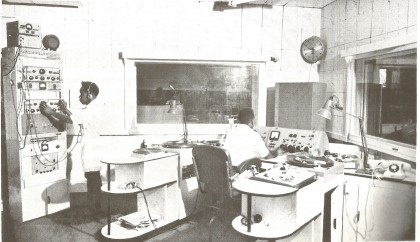RADIO BROADCASTING- 63 YEARS ON AND COUNTING!
At 6 pm on Tuesday 23rd September, 1952, listeners in the British Solomon Islands Protectorate (BSIP) tuning to 1030 kilocycles in the mediumwave band heard these words through their radio sets: “This is station VQO Honiara commencing the initial programme of the Solomon Islands Broadcasting Service”.
The SIBS had been established by the British colonial Government to develop radio broadcasting within the Protectorate and to take-over from the weekly information transmissions previously being carried out on Sunday mornings on the inter-island Teleradio (shortwave) network.
The new SIBS station, VQO, transmitted with a power of 400 watts and used a transmitter built by the Chief Wireless Officer, Ron Calvert, from parts of an old aircraft radio beacon left behind by the US military near Henderson Airport at the end of the war. The first staff members were all volunteers and, apart from Ron Calvert, included William ‘Billy’ Bennett, Kay Poole and, as Programme Director, Colin Allan, at that time the Assistant Secretary to Government.
The first SIBS broadcast was on the air from 6pm to 8pm and started with an address by the High Commissioner for the British colonial Western Pacific, His Excellency Mr. R.C.S. Stanley. He provided a suitably formal and uplifting speech, which included the news that the Headquarters of the High Commission would be moved from Fiji to Solomon Islands and established in Honiara from January, 1953.
After Mr. Stanley’s opening presentation, the Chief Wireless Officer, Ron Calvert, gave a talk on the SIBS and what it hoped to achieve. This was followed at 6.45pm by music from Bill Bennett’s group, known as the Honiara String Band. The opening SIBS programme then included half an hour of music from the popular Hollywood film and stage show, South Pacific, presented by Colin Allan, and concluded at 8pm after more recordings of popular Western dance music and a classical concert.
In the following months, the SIBS broadcast programmes for one hour, 6pm to 7pm, daily except Sundays, before gradually increasing its services to a more regular and longer schedule. The SIBS continued until the 1st January, 1977 when new legislation (passed by Government in 1976) brought into being the independent Solomon Islands Broadcasting Corporation (SIBC).
The establishment of the Solomon Islands Broadcasting Service in 1952 followed five years of information programmes broadcast over the Teleradio network. This weekly, half hour transmission included shipping information, copra prices, Government news and items of general interest and could be heard by any out-stations which had a two-way radio set, such as the AWA 3BZ Teleradio.
The service originally started at 3.30pm on the afternoon of Saturday 18th October, 1947 over Government wireless station VQJ2. At the time, the station was located near the canoe shed close to what is now the Cenotaph in Mendana Avenue, Honiara. It later moved to new quarters on Vavaya Ridge. Bill Bennett was the first Solomon Islander to present information on the weekly programme, while Kay Poole (the Government Public Relations Officer) compiled the news, Ron Calvert handled the technical equipment and David Trench, then Secretary to Government, was in charge of the whole operation. After receiving feedback from listeners, the weekly broadcast changed its schedule and moved to 10.30am on Sunday mornings where it continued for 258 programmes until it was superseded by the SIBS in 1952.
Decorated war hero, Bill Bennett MM, MBE, went on to a full-time career as a broadcaster with the SIBS and became the best-known voice on radio in Solomon Islands. During his service, he undertook many assignments, including a three month training course at the BBC in London and, after retirement, became the first Chairman of the Board of the Solomon Islands Broadcasting Corporation (SIBC).
Prior to World War Two, the British colonial Government had experimented with an information service broadcast from the main wireless station, which was then based at BSIP headquarters at Tulagi in the Florida Islands group. In 1938, a weekly news broadcast (10.15am on Mondays) was transmitted through Tulagi Radio to those out-stations throughout the BSIP which had two-way radio equipment to receive shortwave signals. The service came to an end in late 1939 when World War Two was declared.
However, radio in Solomon Islands goes back even further. In 1923, the Methodist Mission at Roviana, New Georgia purchased a Marconi telephony/telegraphy set and began transmitting messages on the 17th August that year. The main purpose of the station (which could send signals in both Morse code and by voice) was to allow telegrams and other cable traffic to be sent to the Government station, Tulagi Radio, for onwards transmission to Australia, New Zealand and Fiji. However the Mission also allowed its choirs, singing in the Roviana language, to transmit over the wireless to entertain listeners elsewhere within the BSIP. The Mission’s brass band also presented concerts which were heard by passing ships and were used to entertain passengers and crew. The Methodist Mission station was operated by Solomon Islanders, Milton Talasasa, being one of the earliest Morse code signallers to transmit cable traffic.
Wireless in the BSIP was initially established in 1915, when the Government purchased equipment from the Marconi Company in the UK and established Tulagi Radio. The station had its transmitting towers on the flat area of ground near what was then the Tulagi golf course. The station began test transmissions in 1915 and started full service in January, 1916. It carried all Government and commercial messages by Morse code and could send and receive signals as far as Fiji, Australia and New Zealand. The Tulagi Radio building and towers were regularly bombed by Japanese aircraft during World War Two, but were only put out of action when destroyed by Allied naval gunfire during the landings on Tulagi and Gavutu on the 7th August, 1942.
By Martin Hadlow
Formerly Head of Development and Training, SIBC




